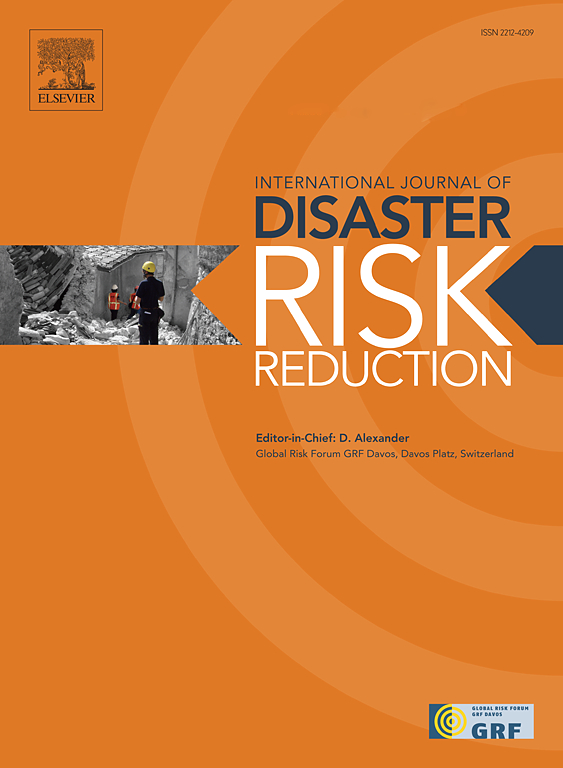基于改进型 FRAME 的紧凑型历史古村落动态火灾风险评估方法
IF 4.2
1区 地球科学
Q1 GEOSCIENCES, MULTIDISCIPLINARY
International journal of disaster risk reduction
Pub Date : 2024-11-01
DOI:10.1016/j.ijdrr.2024.104935
引用次数: 0
摘要
在中国南方山区保存的历史村落中,有大量高价值的遗产地。这些遗址由于布局紧凑、采用木质建筑材料,面临着较大的火灾风险。通过改进工程火灾风险评估方法(FRAME),我们提出了紧凑型历史村落的动态火灾风险评估方法。一方面,在评估指标和权重体系上,通过整合一般性因素和独特的区域性因素,在普遍性和针对性之间建立了平衡。另一方面,通过 "评估-干预-再评估 "的循环运行路径,建立了规范性防火规范与基于性能的设计调整之间的联系。我们选择了曾发生过严重火灾事故的小寨村为例。通过对其原始火灾风险、既定消防干预措施、实际火灾结果和优化消防方案进行对比分析,验证了评估方法的有效性和可靠性。这项研究揭示了村庄的各种因素与建筑火灾风险之间的相关性。在这些因素中,建筑距离、传统习俗和防火布局等原 FRAME 中未包含的因素对火灾风险有显著影响。本研究的结果可为世界各地具有类似特征的历史村落的火灾预防提供参考。此外,所提出的方法还可为各类历史聚落火灾风险评估方法的开发提供启示,从而促进这些聚落建筑遗产的可持续发展。本文章由计算机程序翻译,如有差异,请以英文原文为准。
A dynamic fire risk assessment method for compact historic villages based on the improved FRAME
There are a large number of high-value heritage sites in the historic villages preserved in the mountainous areas of southern China. These sites are exposed to major fire risks due to their compact layout and wooden building materials. By improving the fire risk assessment method for engineering (FRAME), we proposed a dynamic fire risk assessment method for compact historic villages. On one hand, a balance between universality and pertinence was established regarding the assessment indexes and weighting system by integrating general factors with unique regional factors. On the other hand, a connecting link between prescriptive fire codes and performance-based design adjustments was established through the cyclic operation path of assessment-intervention-reassessment. Xiaozhai village, which has experienced serious fire incidents, was selected as an example. Its original fire risk, established fire interventions, actual fire results, and optimized fire protection plan were compared and analyzed to validate the effectiveness and reliability of the assessment method. This study reveals the correlation between various factors of the village and building fire risk. Among these factors, building proximity, traditional customs, and fire protection layout, which are not included in the original FRAME, have a significant impact on fire risk. The results of this study can serve as a reference for fire prevention in historic villages with similar characteristics worldwide. Additionally, the proposed methodology can provide insights into the development of fire risk assessment methods for various types of historical settlements, thus promoting the sustainable development of built heritage in these settlements.
求助全文
通过发布文献求助,成功后即可免费获取论文全文。
去求助
来源期刊

International journal of disaster risk reduction
GEOSCIENCES, MULTIDISCIPLINARYMETEOROLOGY-METEOROLOGY & ATMOSPHERIC SCIENCES
CiteScore
8.70
自引率
18.00%
发文量
688
审稿时长
79 days
期刊介绍:
The International Journal of Disaster Risk Reduction (IJDRR) is the journal for researchers, policymakers and practitioners across diverse disciplines: earth sciences and their implications; environmental sciences; engineering; urban studies; geography; and the social sciences. IJDRR publishes fundamental and applied research, critical reviews, policy papers and case studies with a particular focus on multi-disciplinary research that aims to reduce the impact of natural, technological, social and intentional disasters. IJDRR stimulates exchange of ideas and knowledge transfer on disaster research, mitigation, adaptation, prevention and risk reduction at all geographical scales: local, national and international.
Key topics:-
-multifaceted disaster and cascading disasters
-the development of disaster risk reduction strategies and techniques
-discussion and development of effective warning and educational systems for risk management at all levels
-disasters associated with climate change
-vulnerability analysis and vulnerability trends
-emerging risks
-resilience against disasters.
The journal particularly encourages papers that approach risk from a multi-disciplinary perspective.
 求助内容:
求助内容: 应助结果提醒方式:
应助结果提醒方式:


